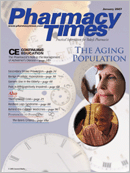Publication
Article
Pharmacy Times
HYPERTENSION WATCH
Acupuncture Ineffective forHypertension
According to a new report from the New England ResearchInstitutes in Watertown, Mass, standardized or individualizedtraditional Chinese acupuncture is no better than a fake procedurein reducing blood pressure (BP) in patients with hypertension.The findings from small clinical trials, as well as studies ofindividual cases, have suggested a possible benefit of acupuncturein patients with high BP in the past. It was only recently,however, that a larger trial has been reported.
The Stop Hypertension with the Acupuncture ResearchProgram enrolled 192 patients with untreated hypertension(average BP 149/93 mm Hg). The researchers randomlyassigned the participants to undergo either standardizedacupuncture, individualized acupuncture, or sham acupuncture.The patients attended up to 12 sessions over the courseof 6 to 8 weeks, and their BP readings were noted every 2weeks for 10 weeks. When all subgroups—age, race, gender,baseline BP, etc—were taken into account, the researcherswere unable to find a significant benefit in any of the 3 groups.(The findings were published in the November 2006 issue ofHypertension.)
Factors Behind Hypertension in Obese Children
Scientists at the University of Chieti in Italy have learned thatadiposity and insulin resistance (IR) could explain why obesechildren are 3 times more likely to be hypertensive, comparedwith their leaner counterparts. In the past, few studies examinedwhether there was a link between adiposity and the presenceof IR and high blood pressure (BP) in children. The scientistsmeasured ambulatory BP parameters, body mass index,and fat mass in 56 obese prepubertal children.
In line with past information on adults, BP parameters weresignificantly related to both adiposity and IR in the children.After controlling for obesity, only the relationship between diastolicBP and IR remained relevant.
The researchers pointed out that this could "possibly indicatea dominant role of IR in influencing diastolic instead of systolicBP values." There was no notable relationship betweenwaist-to-hip ratios and BP parameters, but the researchersnoted that was because of a high percentage of the children inthe study having similar elevated ratios. It was also noted that42% of the children experienced "nondipping phenomena," arisk factor for organ damage in adults. Generally BP levels tendto be lower in the morning, higher during the day, and lower atnight. Those experiencing the phenomena have consistentlyhigh BP. The study's results were published in the Journal ofHypertension (December 2006).
Parents: Reduce Kids' Salt Intake
The findings of a metaanalysisindicated that evenminor reductions in saltintake in children couldlessen age-related bloodpressure (BP) increases,which could correlate to areduction in the risk of futurecardiovascular diseases. Theresearchers stated that currentsalt intake is unnecessarilyhigh in children, andthat could predispose themto hypertension.
The researchers carriedout a meta-analysis of 10trials that included a total of966 children and adolescentsaged 8-16 which studiedthe effects of reducingsalt intake. Overall, the children'sintake of salt waslowered by 42%, which ledto a significant reduction inboth systolic (by an averageof 1.17 mm Hg) and diastolic(1.29 mm Hg) BP. Aseparate analysis of 3 othertrials showed that a 54%reduction in salt intake wasassociated with a 2.47-mmHg drop in systolic BP ininfants.
The researchers concludedthat "a modest reductionin salt intake causes immediatefalls in BP and, if continued,may well lessen thesubsequent rise in BP withage." The findings were publishedin the November 2006issue of Hypertension.
Hypertension More Likely in Teen Boys
A Canadian research team has foundthat adolescent boys are at a greater riskof having high systolic blood pressure(BP) than girls. Their study looked atabout 1300 Montreal teenagers betweengrades 7 and 11, and they sawthat for teen girls, the risk for elevatedsystolic BP remained stable for theiraverage age and height during the timeframe, while the risk for boys increased.When the study started in 1999, thenumbers of boys and girls with normalBP were almost the same, according tolead investigator Kaberi Dasgupta, MD,an internist at McGill University.
By the time the children reached age15, however, boys were twice as likely asgirls to have a BP reading in the toprange for their age and height. By thetime they reached age 17, boys were 2.5times as likely as the girls to have an elevatedBP, and more than two thirds of allchildren with high BP were boys. Theresearchers found a link between beingoverweight and a 2-to 3-fold risk of havinghigh BP among both sexes, and themore sedentary the teens were, thegreater the risk of hypertension. Thefindings were published in theDecember 2006 issue of Circulation.







